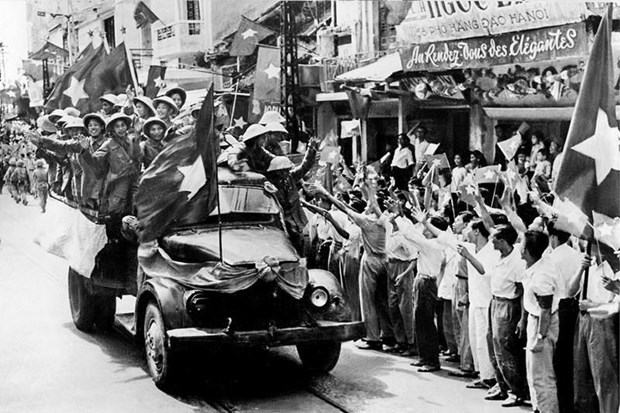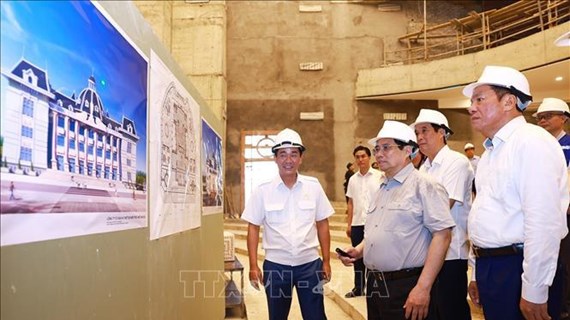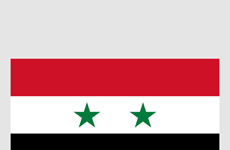Hanoi lives up to ‘Heroic Capital’, ‘City for Peace’ titles
Over the last 67 years, since the liberation of Hanoi from the French colonialists, the local administration and people have made unceasing efforts and obtained numerous achievements to turn the capital city into a development momentum of the northern region and a symbol of patriotism, the love for peace, the spirit of solidarity, and the aspiration to move forward of the entire people.
 A view of Hanoi at night. (Photo: VNA)
A view of Hanoi at night. (Photo: VNA)A brilliant milestone in millennium-long history
 Hanoians welcome the victorious army returning to the capital city on October 10, 1954 morning. (File photo: VNA)
Hanoians welcome the victorious army returning to the capital city on October 10, 1954 morning. (File photo: VNA)After being defeated on the Dien Bien Phu battlefield in May 1954, the French colonialists had to sign the Geneva Agreement, which recognised the independence, sovereignty, and territorial integrity of Vietnam. France withdrew troops from the North of the country.
Under the leadership of the Party Central Committee, the troops and people of Hanoi geared up forces to take over the capital city from France. At 4pm on October 9, 1954, the last French soldiers retreated across Long Bien Bridge, and the Vietnamese army and people took complete control of the city.
In the morning of the next day, the city’s Politico-Military Committee and military units advanced to Hanoi from different directions. The Capital Regiment had the honour of holding the “Determined to Fight, Determined to Win” flag to lead the army that was moving towards Hanoi. Tens of thousands of Hanoians joyfully streamed down to the streets to welcome the victorious army.
October 10, 1954 went down in history as not only a milestone marking the triumph of a small nation over a powerful colonial force, but also the beginning of a new era in Hanoi’s development.
Deserving “Heroic Capital,” “City for Peace” titles
After taking over the capital, the local Party organisation and administration led people to quickly stabilise the situation and restore the city. Only one year later, Hanoi completed the land reform, a basic strategy task of the national democratic revolution.
During the resistance war against the US imperialists, hundreds of thousands of young people from Hanoi joined up to fight. In the rear, the city became a large economic hub of the socialist northern region to provide support for the south in the frontline.
Under the Party’s leadership, Hanoi and other localities secured the “Dien Bien Phu in the Air” victory in December 1972, forcing the US to return to negotiations and sign the Paris Agreement on ending war and restoring peace in Vietnam on January 27, 1973. This was an important prerequisite for Vietnam to obtain the great triumph in the spring of 1975 to reunify the country.
 An aerial view of Ring Road 3 in Hanoi. (Photo: VNA)
An aerial view of Ring Road 3 in Hanoi. (Photo: VNA)On August 1, 2008, Ha Tay province, Me Linh district of Vinh Phuc province, and four communes of Hoa Binh province’s Luong Son district were merged into Hanoi.
Since then, the capital city has continued to make outstanding achievements and act as a role model in all aspects, thereby considerably contributing to national development.
Hanoi has posted good economic growth, at 10.73 percent during 2006 - 2010, 9.23 percent during 2011 - 2015, and 7.39 percent during 2016 - 2020. Despite making up just 1 percent of the total area and 8.1 percent of the population of Vietnam, it contributes 16.46 percent to the GDP and 19.05 percent to the State budget.
The city is now one of the trading, financial, and monetary centres of Vietnam. The industrial sector has been developing, with priority given to the hi-tech and environmentally friendly industries. In agriculture, Hanoi has stepped up the production of farm produce with high quality and value while working to facilitate the growth of clean, hi-tech, and ecological farming.
Meanwhile, local infrastructure has been developed strongly as seen in the construction and operation of key structures such as Nhat Tan Bridge, Vo Nguyen Giap Road, Ring Road 1, extended Road No. 5, Ring Road 2, Vinh Tuy Bridge, and Ring Road 3. As a result, the city has undergone a facelift. Traffic congestion has been reduced substantially, thus bolstering socio-economic development.
In addition, Hanoi has paid attention to cultural and social aspects so as to deserve its status as a cultural centre of the whole country. With the development of education training and healthcare, it is currently a major hub of human resources training and a home to a number of major and modern hospitals.
Thanks to a well-implemented poverty reduction programme, the local household poverty rate was brought down to less than 0.2 percent in 2020. Health insurance now covers over 90 percent of the local population.
Notably, for nearly two years of joining the entire country in combating COVID-19, Hanoi has exerted utmost efforts to contain the pandemic. So far, almost all people aged 18 and above in the city have been given at least one shot of COVID-19 vaccine.
Given its bravery in the struggle for independence and peace, and the aspiration for peace and development, Hanoi has not only earned recognition from the Vietnamese Party, State, and people, but also high esteem from international friends./.













